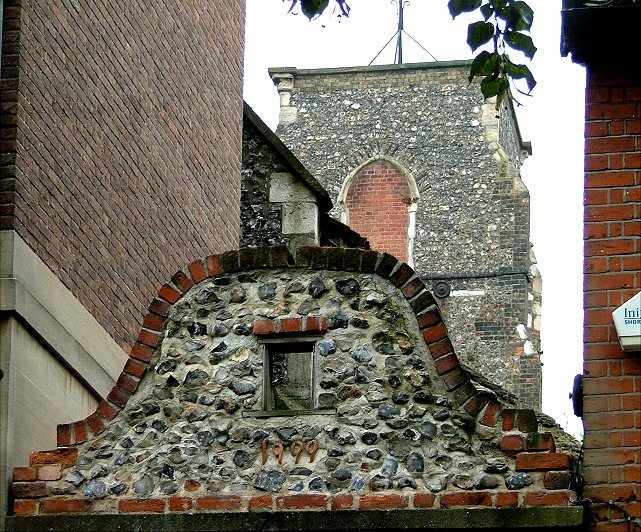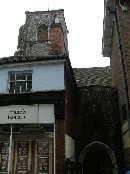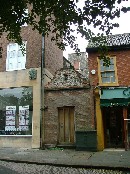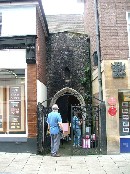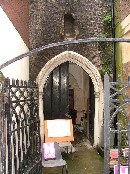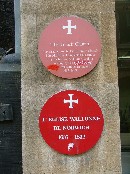| |
|
St Mary
the Less, Norwich If you did not think to look for it, you
would never know that this church was there. Not only is
it surrounded on all four sides by shops and offices, but
it fell out of use in 1544, and has not been in the care
of any mainstream denomination since.
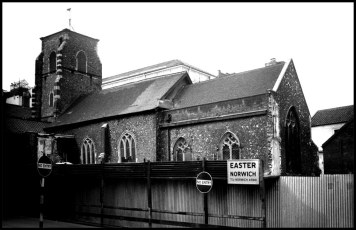 |
|
Only
the tower is visible, peeping above Queen Street,
and then suddenly between two estate agents there
is the squeezed, two storey 14th century porch. A
gateway to the north-west corner of the graveyard
was restored in 1999 and can be found around the
corner in Tombland between another estate agent
and a pizza restaurant, but otherwise you would
never know that this little 13th century church
was there at all. There have been occasional
sightings of this rare beast. In 1958, a row of
shops in Queen Street were demolished to make way
for new buildings, and suddenly the vista to the
left was opened up, for George Plunkett to
photograph. It was as if Norwich had gained a new
medieval church; and, within a few months, it was
gone again.
|
It would
not have been unusual before the 19th century to find a
church completely surrounded by shops and houses -
indeed, Norwich's second biggest church, St Andrew, was
like this into the 20th century. And several town
churches found new functions after the Reformation. But
St Mary the Less so convincingly fell from sight that it
almost disappeared altogether.
On its
redundancy in the 16th century, it was sold to Norwich
Corporation, and became a merchant hall where Dutch and
Walloon merchants sold their cloth. This continued until
the 1620s, when falling demand meant that the Corporation
rented it out to the local Worsted merchants, who used it
for a while. In 1637 it was bought by the Flemish Walloon
Company to be converted into a French Protestant church.
Among the famous members of the congregation were the
Martineau family, who are commemorated by several
plaques. The difference between Walloons and Hugenots is
one of region rather than belief, but the Norwich
heritage trail plaque that refered to this as the
'Hugenot church' has been vandalised, presumably by
Flemish nationalists, and altered to read 'Walloon
church'.
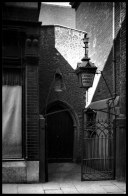 |
|
By
1832, the French Protestant community had been
fairly fully integrated into Norwich
non-conformist life, and the lease was sold to
the Swedenborgians. This protestant cult
flourished briefly in the mid-19th century before
fading, and, as a consequence, the lease passed
in 1869 to one of the most astonishing
denominations ever to arise on English soil, the
Catholic Apostolic Church, or the Irvingites, as
they were known after their founder. The Church
was bankrolled by fabulously wealthy aristocrats,
and in several towns and cities they built
churches on a Cathedral scale, including the
magnificent Church of Christ the King in London's
Gordon Square. The fact that they leased a church
rather than building one in Norwich suggests
perhaps that Norfolkers were rather less than
overwhelmed by Irving's fusion of high church
ritual with madcap theology. A lamp with their
name on hung above the Queen Street entrance for
George Plunkett to photograph in 1937. He also
took some images of the inside, rare surviving
evidence of the liturgical arrangements of this
curious denomination.
|
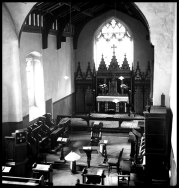 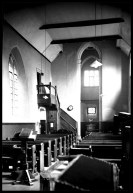 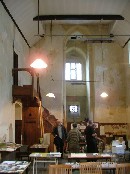
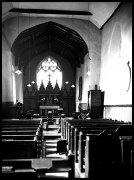 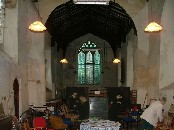 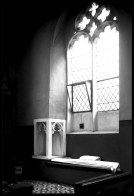
Incredibly,
for what was essentially a bizarre Victorian spiritual
fancy, the Catholic Apostolic Church here lasted into the
1950s, when the last of the Norwich congregation died
off. The building then became a furniture store.
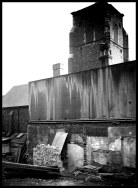 |
|
A builder's yard to the
north of the church provided a vista in the
interwar years, but this was all built up in the
1950s. When I first visited here in the
mid-1990s, the church had just been sold by the
same trust which, amazingly, had been formed in
1832 to convey ownership of the lease to the
Swedenborgians. The building was bought by a
curious organisation which proclaimed itself 'the
Dutch and Flemish studies centre' . At first, I
thought that they must be something to do with
the University, and the people I spoke to at the
time did not deny this, but I do not think that
it was so. The church was just a bare shell then,
and I came back ten years later expecting to find
a brave modernisation with a library, lecture
room and a study centre.
This
was not the case at all. Stepping into the south
porch, and then into the church, I found that the
building is little different to how it had been a
decade before, except possibly damper and
dingier.
|
| There
has been no refurbishment at all. It is also a
lot more cluttered, mainly full of display cases
about the history of the Walloon community in
Norwich. There are a couple of interesting
details inside. The tower arch is extraordinary,
a a narrow, tall affair that reaches right to the
roof. The staircase that leads to the room over
the porch dates from the use of the building by
the Catholic Apostolic Church, as does the
coloured glass in the north door. Two large
portraits of dour Dutch protestants block the way
into the chancel - a statement of religious
belief if ever there was one.
|
|
 |
Simon Knott, November 2005
|
|
|

